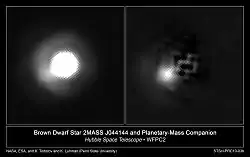2MASS J04414489+2301513
2MASS J04414489+2301513 (often abbreviated as 2M J044144) is a young star system hosting a planet and a couple of brown dwarfs, approximately 470 light years (145 parsecs) away.
| Observation data Epoch J2000 Equinox J2000 | |
|---|---|
| Constellation | Taurus |
| 2MASS J04414489+2301513 | |
| Right ascension | 04h 41m 44.898s[1] |
| Declination | +23° 01′ 51.39″[1] |
| Apparent magnitude (V) | |
| 2MASS J04414565+2301580 | |
| Right ascension | 04h 41m 45.652s[1] |
| Declination | +23° 01′ 58.07″[1] |
| Apparent magnitude (V) | 15.20[2] |
| Characteristics | |
| Spectral type | M8.5[3] |
| Astrometry | |
| Proper motion (μ) | RA: 7.918[4] mas/yr Dec.: -20.152[4] mas/yr |
| Parallax (π) | 8.1822 ± 0.3044[4] mas |
| Distance | 400 ± 10 ly (122 ± 5 pc) |
| 2MASS J04414565+2301580 | |
| Proper motion (μ) | RA: 7.914[5] mas/yr Dec.: -22.086[5] mas/yr |
| Parallax (π) | 8.0887 ± 0.0713[5] mas |
| Distance | 403 ± 4 ly (124 ± 1 pc) |
| Details | |
| 2MASS J04414489+2301513 | |
| Mass | 19 ± 3 / 9.8 ± 1.8[6] MJup |
| Luminosity | 0.00347 / 0.00093[6] L☉ |
| Temperature | 2100 / 1800[6] K |
| Age | 1[3] Myr |
| 2MASS J04414565+2301580 | |
| Mass | 0.20+1.0 −0.05 M☉ / 35 ± 5[6] MJup |
| Luminosity | 0.14 / 0.00741[6] L☉ |
| Temperature | 3400 / 2800[6] K |
| Age | 1[3] Myr |
| Other designations | |
WDS J04417+2302AB, Gaia EDR3 146487556211644544 | |
| Database references | |
| SIMBAD | 2M J044144 |
| 2M J044145 | |
The 2MASS J04414489+2301513 primary (a brown dwarf) has a large separation (12.4 arcseconds) companion, 2MASS J04414565+2301580 (abbreviated as 2M J044145), which in turn has a nearby small separation substellar companion (separation of 0.23 arcseconds to the northeast). 2M J044145 has similar proper motion to 2M J044144 and is likely physically associated with the system.[7] The entire system of 4 objects is then a hierarchical quadruple of two binary stars orbiting each other.[7] The primary component has a spectral type of M4.5 and a red apparent magnitude of 14.2.[6] Both components seem to be accreting mass from their stellar disks, as shown by their emission lines.[6] The four stars have a total mass of only 26% of the Sun, making it the quadruple star system with the lowest mass known.[6]
Planetary system
The primary is orbited by a companion about 5–10 times the mass of Jupiter.[8] The mass of the primary brown dwarf is roughly 20 times the mass of Jupiter and its age is roughly one million years.[3]It is not clear whether this companion object is a sub-brown dwarf or a planet. The companion is very large with respect to its parent and must have formed within 1 million years or so. This seems to be too big and too fast to form like a regular planet from a disk around the central object.[3]
| Companion (in order from star) |
Mass | Semimajor axis (AU) |
Orbital period (years) |
Eccentricity | Inclination | Radius |
|---|---|---|---|---|---|---|
| b | 7.5±2.5 MJ | 15±0.6 | 411 | — | — | 1.13 RJ |
References
- Cutri, R. M.; et al. (2003). "2MASS All-Sky Catalog of Point Sources". VizieR On-line Data Catalog. 2246. Bibcode:2003yCat.2246....0C.
- Zacharias, N. (2012). "The fourth US Naval Observatory CCD Astrograph Catalog (UCAC4)". VizieR On-line Data Catalog. 1322. Bibcode:2012yCat.1322....0Z.
- Todorov, K.; Luhman, K. L.; McLeod, K. K. (2010). "Discovery of a Planetary-Mass Companion to a Brown Dwarf in Taurus". The Astrophysical Journal. 714 (1): L84–L88. arXiv:1004.0539. Bibcode:2010ApJ...714L..84T. doi:10.1088/2041-8205/714/1/L84. S2CID 119242529.
- Brown, A. G. A.; et al. (Gaia collaboration). "Gaia Early Data Release 3: Summary of the contents and survey properties". Astronomy & Astrophysics (in press). arXiv:2012.01533. doi:10.1051/0004-6361/202039657. S2CID 227254300. Gaia EDR3 record for this source at VizieR.
- Brown, A. G. A.; et al. (Gaia collaboration). "Gaia Early Data Release 3: Summary of the contents and survey properties". Astronomy & Astrophysics (in press). arXiv:2012.01533. doi:10.1051/0004-6361/202039657. S2CID 227254300. Gaia EDR3 record for this source at VizieR.
- Bowler, Brendan P.; Hillenbrand, Lynne A. (2015). "Near-infrared Spectroscopy of 2M0441+2301 AabBab: A Quadruple System Spanning the Stellar to Planetary Mass Regimes". The Astrophysical Journal. 811 (2): L30. arXiv:1509.01658. Bibcode:2015ApJ...811L..30B. doi:10.1088/2041-8205/811/2/L30. S2CID 22608263.
- Todorov, K. O.; Luhman, K. L.; Konopacky, Q. M.; McLeod, K. K.; Apai, D.; Ghez, A. M.; Pascucci, I.; Robberto, M. (2014). "A Search for Companions to Brown Dwarfs in the Taurus and Chamaeleon Star-Forming Regions". The Astrophysical Journal. 788 (1): 40. arXiv:1404.0213. Bibcode:2014ApJ...788...40T. doi:10.1088/0004-637X/788/1/40. S2CID 16636388.
- "Hubble spots giant planet orbiting tiny star". USA Today. 2010-04-07. Retrieved 2013-02-24.
- Jean Schneider (2011). "Notes for star 2M J044144". Extrasolar Planets Encyclopaedia. Archived from the original on 19 January 2012. Retrieved 30 September 2011.
